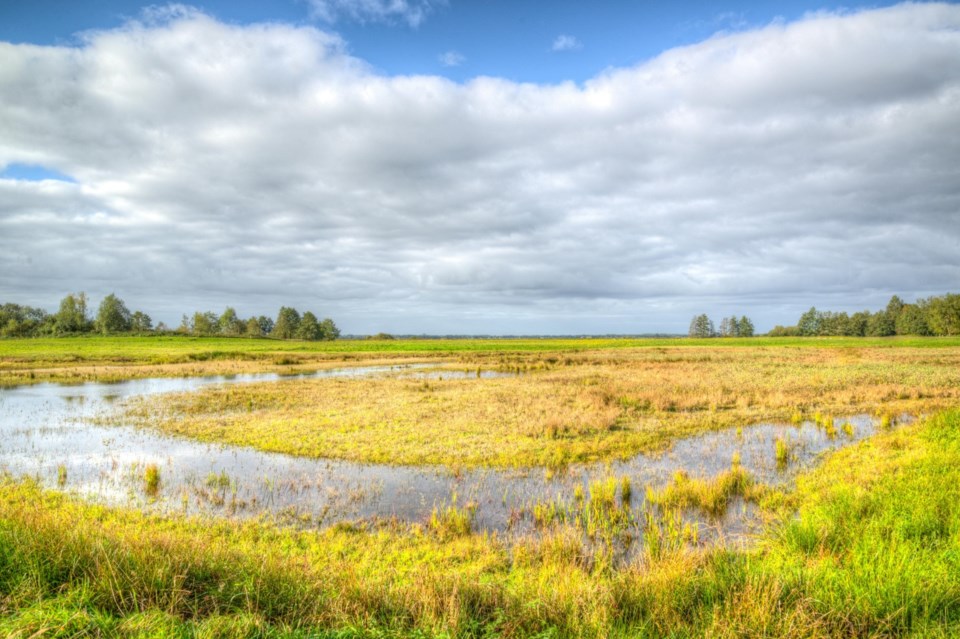HEPBURN — The monthly gathering of the Prairie Rivers Reconciliation Circle was held in Hepburn at Heritage Common on March 26, with 22 members in attendance and six more attending via Zoom. The educational component of the gathering involved a viewing of the follow-up documentary to Reserve 107: Reconciliation on the Prairie, Reserve 107: A Path Forward, and a discussion.
In 1876, Chief Chipeewayan and four headmen signed onto Treaty 6 at Fort Carlton. When Chief Chipeewayan passed away in 1877, his son, Young Chipeewayan, became the hereditary chief, and the Department of Indian Affairs adopted his name as the proper name for the band. A reserve was surveyed in 1879, which designated 77 square kilometres of land near Laird, Sask, as the Stoney Knoll Reserve. However, in the years that followed, a series of challenges made it difficult to sustain the 80-person population on the reserve land. With dwindling buffalo herds and difficulties with a transition to farming, which the government wanted but did not supply the resources for, food was scarce, and the band was forced to leave the area in search of food.
“Largely due to starvation, they ended up leaving that land to look for food, and they landed up at Cypress Hills,” said Leonard Doell from the Mennonite Central Committee in Saskatchewan.
The Department of Indian Affairs started withholding payments from Young Chipeewayan band members in 1885 because it suspected members had participated in the Riel rebellion. By 1888, it no longer identified the Young Chipeewayan as a separate band, and in 1895, talks were underway about dispossessing the band of its land. The minister for the Interior concluded it did not need consent from the band and moved to transfer the members to other reserves, where they were not always welcomed.
In the meantime, their reserve land was taken away from them in 1897, and the former Young Chippewayan Indian Reserve became a Reserve for Mennonite farmers, and a few years later, German Lutherans started to settle there as well. Now, 130 years later, the Mennonite and Lutheran communities are working with descendants of the Young Chipeewayan, also known as the Stoney Knoll Band, toward a land claim settlement.
Starting in the 1970s, First Nations descendants visited businesses and Laird town officials, insisting that a treaty signed by the Government of Canada and their people stated that the land local people owned and farmed belonged to an Indigenous First Nation. The information that the land around Stoney Knoll had once been designated as a reserve was not something anyone had heard of, and people were defensive and anxious about what was going to happen. Treaty awareness and education were unheard of at that time, and the term “land claim” was inferred by many to mean that farm families would be dispossessed of land they had lived on and tended for decades.
In the early 1990s, descendants of the Young Chipeewayan First Nation submitted a specific land claim. However, in 1994, the Indian Claims Commission inquiry concluded that under the Indian Act and the law, the claimants were not a band and, as individuals, were not entitled to submit a claim; therefore, the claim was rejected. However, the inquiry did conclude that “Canada’s subsequent conduct involving a unilateral decision to transfer Stoney Knoll Reserve No. 107 without consent or compensation was a breach of Treaty 6.”
In 2006, the late Chief Ben Weenie, his wife Sylvia, and Gary LaPlante, descendants of the Young Chipeewayan Band, met with Mennonite and Lutheran leaders to share their story and discuss the future, and on August 22, 2006, 130 people gathered at Stoney Knoll, a sacred place to the Young Chipeewayan people and St John’s Lutheran Church, to Commemorate the 130th Anniversary of the signing of Treaty Six and to continue the journey of building friendship and understanding. Chief Weenie emphasized that this was not a time of confrontation, but a time of healing between the peoples. The emphasis was one of spiritual healing, where, perhaps, said Chief Weenie, they "could set an example to the rest of the country for how our peoples could live in peace and harmony with each other." Chief Weenie made it clear that the Young Chippewayan respected the current ownership of the land by the settlers, and they did not want to displace other people, in order to continue the process. ‘We all know what it feels like to be displaced people,’ he said. In turn, the Mennonite and Lutheran communities pledged support for the Young Chippewayan band in its ongoing struggle to obtain compensation for the land owed to them under Treaty Six, signing a Memorandum of Understanding to that effect.
“We were able to put any kind of discussions about past wrongs; we put that all aside,” said LaPlante. “We were talking reconciliation before reconciliation became a catchphrase in Canada.”
Reconciliation is something done together. It involves engagement of both sides and a commitment to strive for something better. The story of the Young Chipeewayan band and the partnership with the Mennonite and Lutheran communities is the subject of the documentary, Reserve 107. In the follow-up, Reserve 107: A Path Forward, the filmmakers provide a platform for the Young Chipeewayan and their Mennonite and Lutheran partners to share what has come out of those initial efforts at reconciliation.
Chief Ben Weenie passed away in the winter of 2016-17, but he knew that working cooperatively together was the way to move forward … and friends can solve more problems than adversaries can.
The original documentary was shown to Senators in Ottawa in 2017, at the initiative of Senator Lillian Dyck, who, believing it was a story that needed to be told, brought a group including descendants of the Young Chipeewayan, Mennonites, and Lutherans to Ottawa to address the Senate. Barb Froese, who, together with her husband Wilmer, owns the land which surrounds Stoney Knoll, addressed the Senators saying, “This story is not just about making things right, although we hope that can happen. But it’s an acceptance of each other as equals worthy of respect. It’s about making the invisible visible.”
The wheels of government turn ever so slowly, but the friends continue to meet and gather at “the hill” for ceremonies and gatherings. To help future visitors learn the history, Wilmer Froese initiated a project to create an interpretive path with storyboards, telling the history of the place and the journey of reconciliation over the last 17 years. The path and storyboards were developed by the Stoney Knoll Historical Committee, a group with Indigenous, Mennonite and Lutheran representation, in collaboration with the office of the Treaty Commissioner. On July 20, 2022, they met to celebrate the installation of the storyboards. The Honourable Marc Miller, Minister of Crown and Indigenous Relations, attended and committed to not ignoring the land claim submitted by the Young Chipeewayan for Reserve 107. In August of 2022, the Government of Canada stated that it met the minimum standard to proceed, which is the first hurdle in having the land claim fully recognized.
Fast forward to 2024. Substantive negotiations had not even started, although an offer to settle the claim once and for all, to negotiate a final settlement, was made by the ministry. Before negotiations can begin, the ministry wants the Stoney Knoll people to address two things: 1) How are the descendants of Stoney Knoll going to compensate the First Nations that had adopted and brought in their ancestors? Those First Nations will also need to agree to release the Stoney Knoll people from their registers. 2) The Stoney Knoll people need to be sure that they want to be recognized as a First Nation by the Government of Canada, even though they do not know what all that will entail.
At the end of the second documentary, LaPlant states, “The reconciliation story continues to be a good one. We from Stoney Knoll came to Laird, Saskatchewan, to them, to these Mennonites and Lutherans, as people, as grassroots people. So, from there was the foundation for all of this, where we are at (sic) today.
“…We didn’t go to the Government of Canada to ask for money to have a reconciliation gathering. We didn’t go to the Federation of Sovereign Indigenous Nations and ask them ‘Please, put on a gathering for us. You guys are our leaders.’ We didn’t go to the Assembly of First Nations and ask them. No, this is a grassroots movement. We came to the people actually living on the land…we came to yourselves, and it is a true grassroots movement. True reconciliation is about people like this. For us to be able to sit together and none of us feel threatened; for none of us to feel that we have hidden agendas. Our friendship is what it is, it is true; it is true friendship.”




